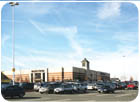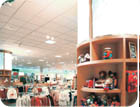
Nordstrom department store managers encourage their sales staff to remember their customers' names and clothing sizes to make the customer feel important and above all, keep them coming back.
Customer service is not just ingrained into the staff at Nordstrom, the interior finishes also are designed to accomplish several goals, including providing the shopper with an inviting respite. The building and design teams also give the staff a functional marketplace in which to work that draws in shoppers.
"While our customers explore our store, we attend to the details that add value to the Nordstrom experience-spacious aisles, convenient restrooms, public seating and plenty of amenities," according to Nordstrom staff.

The designs of the BPB America Celotex Brand Baroque ceiling panels were used to help brighten the store's clothing layout and amplify showroom touches, such as the live piano music played by a musician at a baby grand.
"The ceiling panels and the retail environment are a perfect match," says Ceiling Systems Manager David Todd for BPB.
The Baroque series are deep scored to complement the suspension system and mask the metal grid, while the scoring patterns create lines that compel movement toward the ample racks of merchandise and latest fashions on fully coiffed mannequins.

Look and feel
In today's competitive marketplace, the retail manager looks for every way to hold down costs while maximizing the store's customer-friendly look. The panels offer a .80 light reflectance that, in combination with daylight from large display windows and programmable lighting controls, can slash energy costs to bargain basement levels.The light reflectance of ceiling panels is also important in the new regulatory environment for shops and restaurants in which several state governments have significantly reduced the number of allowable watts per square foot permitted by the lighting.
The states are merely complying with what the U.S. Dept. of Energy mandated on July 2004, a requirement that all states adopt an energy code that meets or exceeds the minimum requirements of ANSI/ASHRAE/IESNA Standard 90.1-1999, "Energy Standards for Buildings Except Low-Rise Residential Buildings."
Dating back to 1972, the Standard 90 Series has provided efficiency design criteria for a building's walls, roof, windows, lighting and mechanical systems. Some states, such as California, already have more stringent requirements.
Non-residential buildings in California, including retail stores, also have mandatory requirements to lower the power of their interior lighting under the latest revisions to the Title 24 energy code that took effect in October 2005.
These regulations may not seem like a blessing but lower wattage lamps and fixtures used in conjunction with high light reflective ceiling panels have benefits in disguise. The low-watt light fixtures may cost more up front but they produce lower heat levels on showroom floors and that lowers air conditioning costs.
The architect and interior designer who specifies high light reflective ceiling panels is using one of a growing number of strategies, which can also include installing fixture reflectors, that can further reduce the life-cycle cost of a new building.
Before selecting a ceiling and lighting, designers are now looking at the affects those systems have on both sides of the balance sheet, including energy costs on one side and sales on the other.
The lighting must strike a balance between low energy consuming dimmed background lighting to create the right ambiance leading up to the display cases, while more expensive to operate spot illumination must showcase products to help sell them. The U.S. Dept. of Energy estimates that 37 percent of a retail store's energy consumption goes toward lighting. Still, ambient lighting, special displays and outdoor signs need to be running to get the merchandisers message out and to get people in the store.

Low maintenance
The cleaning crew at the Nordstrom Dulles Town Center like working with the Baroque ceiling panels because of the panel's durability, which is provided by BPB America's built-in technology that has been perfected over decades of research.The panel's finished texture is the most popular pattern produced, giving corporate officers and franchisees the comfort of knowing the ceiling will provide them the consistent image they want to maintain the visual effects of their brand and identity.
More and more retailers are finding green strategies fit with their brand story as they seek out low-wattage lighting, lower VOC paints, no added formaldehyde cabinetry and reduced-flow water and plumbing fixtures, among other design initiatives.
Building product manufacturers often are able to help provide information for green retail projects with data sheets on the LEED Green Building Rating System and BPB can provide Celotex brand wet-felted acoustical ceiling products (ASTM E 1264, Type III, For 2 - Water Felted). The brand can qualify for LEED-NC Energy & Atmosphere Credit 1, Optimize Energy Performance; and under Material Resources: Credit 2.1 and 2.2 Construction Waste Management; and Credit 4.1 and 4.2 Recycled Content.
IBEX Construction of Washington, built the two-story Nordstrom anchor store for the existing Dulles Town Center shopping mall, which is owned by the Dulles Town Center LLC, partnered with Lerner Enterprises, based in Bethesda, Md. The retail store covers 144 square feet of a new wing in the Town Center, which is called the Town Court Wing. BPB supplied about 118,000 square feet of ceiling panels for the project.
The architect is Callison Architecture of Seattle, a designer of retail, hospitality, corporate, healthcare and mixed-use destinations.
"Callison designs attract the business, people and activity that lead to sustained performance," says Tracey Compton, communications specialist for Callison. "Retailers who spend more energy understanding and interpreting who they are for their customers, rather than seeking innovation for its own sake, win customer trust."
That's why Seattle-based Nordstrom's continues to offer its trademark complimentary gift boxes, concierge service and personal shoppers to keep the customer coming back for repeat experiences.
If you read this article, please circle number 330.
